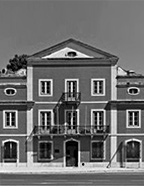

................................
The foundation occurred on 8 December 1720, and the 1st Director, D. Manoel Caetano Sousa, was appointed along with four censors: the Marquis of Fronteira, the Marquis of Abrantes, the Marquis of Alegrete and the Count of Ericeira. The Secretary was the Count of Villamayor. On 22 December, the statutes were presented and approved, divided into ten chapters where, in addition to its organisation and members, it was established that "the Academy shall have a seal and company... the seal shall be composed of the shield of the Royal Arms, and below it the figure of Time bound by chains, and this title: Sigillum Regiae Academiae Historiae Lusitanae. The Company shall be the simulacrum of Truth, as represented by the Ancients, with the following: Restituet omnia", and it was this Company to which the Portuguese Academy of History returned.
The main characteristic of the goal established by the Royal Academy was the imposition of a method, without which the work would not be accepted as scientific. To this end, the following were defined as prerequisites for subsequent activity: "gathering manuscripts"; "summoning writers" and obtaining the protection of the Royal Power, "because without it the archives cannot be opened, nor can that which they contain or what is buried therein be discovered...".
Beginning with the distribution of specific tasks, a draft of a questionnaire was then drawn up to be sent to Town Halls, Parishes, Monasteries and Archives , on the basis of whose answers each academic would work. They would report back to the rest of their peers on this work at scheduled meetings. This was followed by a discussion of the problem, and only once a consensus had been reached would the author be able to write his text. The text was required to be presented in a pure and clear style and not in the form of an Annals. It was to be divided into subjects and only within each was it to follow a chronological order. And, considering that "geography and chronology are the two eyes of history", in the case of doubts relating to geography, everyone shall conform to what is established by the experts. As regards chronology, the era of Christ shall be followed; the Hegira is deemed to be in 622; the acclamation of King Afonso Henriques in 1139; the law of King John I for use of the era of Christ, in 1422".
